Statement on Monetary Policy – November 2017 6. Economic Outlook
The International Economy
Global economic conditions have improved since mid 2016 across a broad range of economies. The near-term outlook for growth in Australia's major trading partners is a little stronger than at the time of the August Statement on Monetary Policy. Major trading partner growth is, however, still expected to ease a little over the next couple of years (Graph 6.1). In the medium term, growth in Australia's trading partners will depend on their potential output growth, which is difficult to estimate. Some long-term structural factors, such as the decline in working-age population in a number of important trading partners, including China, Japan and Korea, will place downward pressure on potential growth. On the other hand, sustained periods of stronger economic activity generally lead to stronger investment growth, which adds to an economy's productive capacity and potential growth over time; investment growth has already picked up in the major advanced economies and in the high-income economies in Asia relative to recent years. Furthermore, cyclically tight labour markets tend to induce higher labour force participation, which may add to labour supply and thus potential output; there is already evidence of this occurring in a number of advanced economies where participation rates of females and older workers have increased over the past decade.
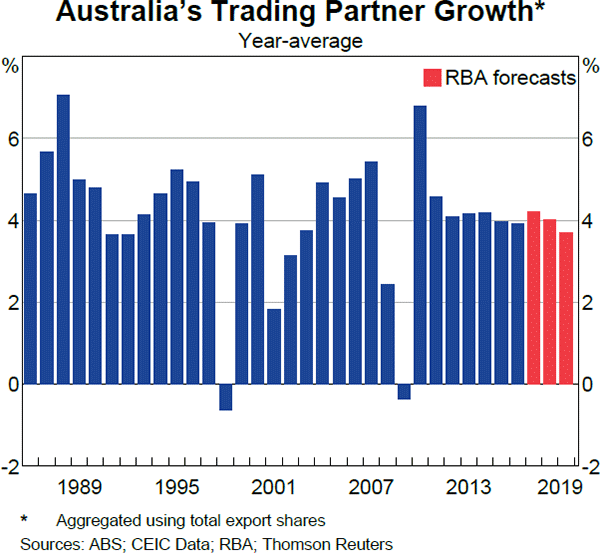
In China, near-term growth is expected to be a little stronger than previously forecast, reflecting recent data. Statements made by Chinese officials at the 19th Party Congress foreshadow broad continuity in economic policy in the period ahead. In the near term, growth is expected to receive continued support from accommodative policy settings, but is still likely to slow gradually in the longer term for structural reasons, such as the declining working-age population. The east Asian economies (other than China and Japan) are expected to grow at around potential over the forecast period, supported by the improvement in the global economy and an expected pick-up in domestic demand.
GDP growth in the major advanced economies is expected to be above potential growth over the next couple of years, partly because monetary policies are expected to remain largely accommodative (although in some cases, less so). Considerable uncertainty remains about the economic policies of the US administration, including the prospect of substantial tax reform resulting in fiscal stimulus.
Although still low, wage growth has increased in some of the major advanced economies that are close to, or at, full employment. Wage pressures are expected to increase gradually as spare capacity in these economies' labour markets declines further. This should put upward pressure on inflation in the next couple of years. However, uncertainty about potential output translates into uncertainty about how much spare capacity exists. If there is more capacity in these economies than projected, for example, inflation could rise more slowly than currently forecast, which would have implications for the path of monetary policy and possibly exchange rates.
Chinese steel demand is expected to be lower over the forecast period and further increases in low-cost supply of bulk commodities are in the pipeline. Consequently, the terms of trade are expected to decline, but to remain above their trough in early 2016 (Graph 6.2).
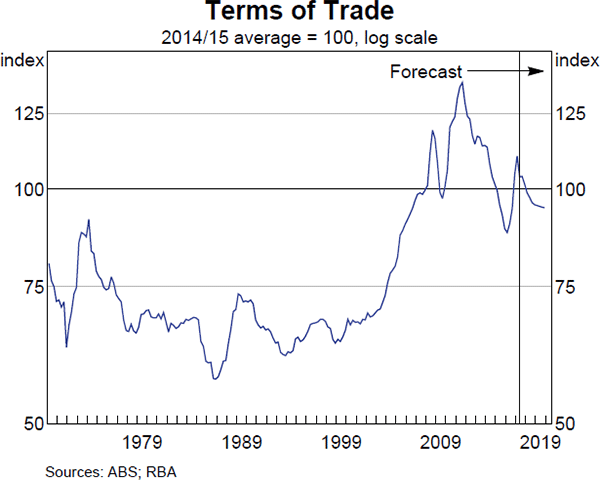
Domestic Activity
The forecast for domestic output growth is little changed from the August Statement (Graph 6.3; Table 6.1). Domestic GDP growth increased in the June quarter, in line with expectations, although there were some differences at the component level. Growth looks to have been modestly slower in the September quarter, but is expected to have been around estimates of potential growth in year-ended terms. GDP growth should strengthen over the rest of the forecast period as the drag from mining investment comes to an end and public demand and non-mining business investment continue to support growth. Although economic growth is forecast to be above potential before 2019, it is expected to take some time for the economy to encounter broad-based capacity constraints.
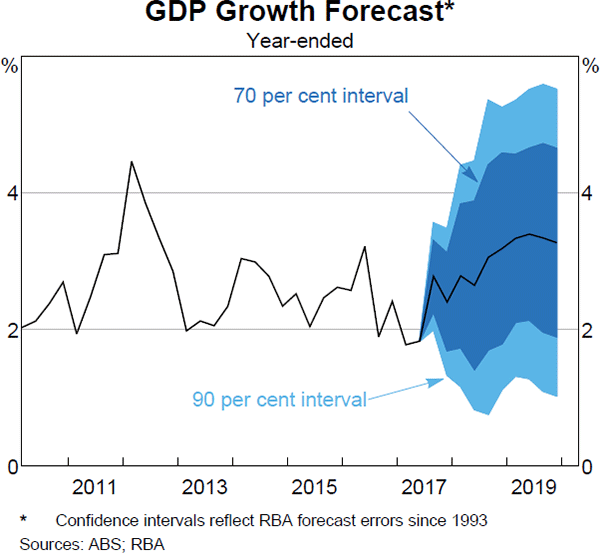
| Year-ended | ||||||
|---|---|---|---|---|---|---|
| Jun 2017 | Dec 2017 | Jun 2018 | Dec 2018 | Jun 2019 | Dec 2019 | |
| GDP growth | 1.8 | 2½ | 2¾ | 3¼ | 3½ | 3¼ |
| Unemployment rate(b) | 5.6 | 5½ | 5½ | 5½ | 5½ | 5¼ |
| CPI inflation | 1.9 | 2 | 2 | 2¼ | 2¼ | 2¼ |
| Underlying inflation | 2 | 1¾ | 1¾ | 1¾ | 2 | 2 |
| Year-average | ||||||
| 2016/17 | 2017 | 2017/18 | 2018 | 2018/19 | 2019 | |
| GDP growth | 2.0 | 2¼ | 2¾ | 3 | 3¼ | 3¼ |
|
(a) Technical assumptions include A$ at US$0.77, TWI at 65 and Brent crude oil price at US$63 per barrel; shaded regions are historical data Sources: ABS; RBA |
||||||
The domestic forecasts are conditioned on a number of technical assumptions. The cash rate is assumed to move broadly in line with market pricing. This does not represent a commitment by the Reserve Bank Board to any particular path for policy. The exchange rate is assumed to remain at its current level over the forecast period, which is around 3 per cent lower on a trade-weighted basis than in the August Statement. The forecasts are also based on the price of Brent crude oil being around US$63 per barrel, which is about 19 per cent higher than the assumption used in August and in line with futures pricing in the near term. The population aged over 15 years is assumed to grow by 1.6 per cent over the next few years.
Mining activity is expected to contribute positively to growth over the forecast period. While most of the decline in mining investment has already occurred, further small falls are anticipated as construction on liquefied natural gas (LNG) projects comes to completion. Mining investment has been revised slightly higher, reflecting cost overruns at some LNG projects. The level of mining investment should stabilise in the second half of next year; while very few new large projects are expected to commence, major mining firms are likely to invest more to maintain their existing productive capacity, although most of this activity is expected to occur outside the forecast period.
LNG exports are expected to contribute around ½ percentage point to GDP growth in 2017 and just above ⅓ percentage point to annual growth in each of the two subsequent years as existing plants ramp up production and new plants come online. The contribution has been revised slightly lower over the forecast period because some projects have experienced delays and the expected level of production has been revised lower at some other projects. Iron ore export volumes are forecast to rise only a little further in the period ahead as additional production capacity from Australia's low-cost producers comes on line.
Growth in non-mining activity is projected to pick up over the forecast period as a result of continued growth in household consumption and non-mining business investment. Public demand is also expected to support economic growth. In contrast, dwelling investment appears to have peaked earlier than previously anticipated. Although the significant pipeline of work still to be done should mean that the level of residential construction activity remains high over the next year or so, dwelling investment is not likely to contribute to GDP growth over the forecast period.
Household consumption growth is forecast to pick up a little, but to a rate that is lower than the average seen prior to the financial crisis. The small pick-up is supported by stronger growth in employment and the forecast gradual increase in wage growth, and implies a modest decline in the household saving ratio. The outlook for household income growth represents a significant uncertainty for the consumption forecasts.
Non-mining investment is forecast to increase, supported by low interest rates, an increase in expected infrastructure activity, the expected pick-up in GDP growth and the diminishing impact of falling mining investment on other sectors of the economy. Recent revisions to the national accounts data indicate that non-mining investment has been stronger than previously thought and has increased by almost 10 per cent since the start of 2016. As such, the level of non-mining investment is now higher compared with the previous Statement and there appears to be more momentum in growth than previously appreciated. These revisions have reduced some of the downside risk to the non-mining investment forecast and, given the relatively gradual increase that is expected, there is a risk that investment will pick up by more than forecast.
The recent strength in public investment is expected to continue, largely driven by transport and telecommunications infrastructure projects that are already underway or will start in the near future. Much of this work is being undertaken by the private sector for the public sector and liaison contacts have started to report that these public contracts have encouraged private sector investment in machinery and equipment. This suggests another source of upside risk to the non-mining business investment forecasts. Public consumption is being supported by the rollout of the National Disability Insurance Scheme and is forecast to grow at around its average since the early 1990s.
Employment growth has been revised a little higher in the near term because recent data and the signal from leading indicators of labour demand both suggest there has been more momentum in the labour market over recent months than previously anticipated. Employment is expected to grow a little faster than the working-age population over the rest of the forecast period, as GDP growth picks up. Consistent with this, the unemployment rate is expected to decline to around 5¼ per cent by the end of 2019 (Graph 6.4). Average hours worked are expected to increase a little and this should see broader measures of spare capacity, such as the underemployment rate, decline as well. The participation rate, which has risen quite sharply over the past year, is expected to increase a little further as better labour market conditions encourage those who are marginally attached to the labour market to enter and older workers to delay retirement. This is expected to offset any small downward effect of ageing on the participation rate.
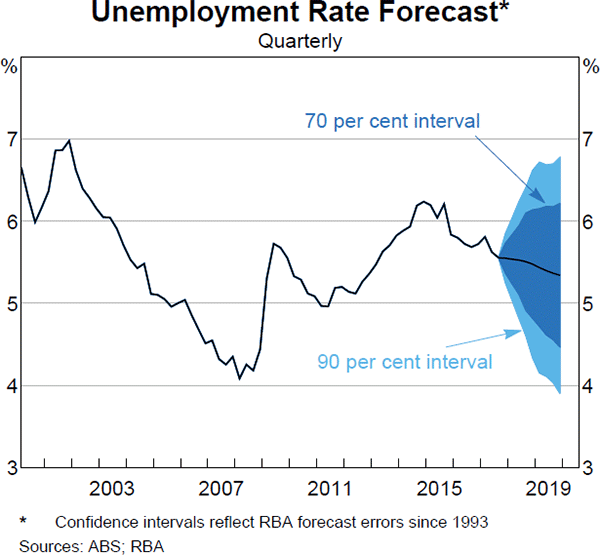
There has been little change to the wage price index forecasts since the August Statement. Over the next few years, wage growth is expected to rise gradually as spare capacity in the labour market is absorbed and as the adjustment to the decline in the terms of trade comes to an end. Indeed, the stronger labour market conditions over the past six months provide more confidence around this forecast. Business surveys and information from liaison suggest some industries are starting to find it difficult to attract suitable labour, though there is little evidence that this is translating into higher wage growth more generally. At the same time, wage growth in newly negotiated enterprise agreements has declined. Notwithstanding the expected pick-up, wage growth is expected to remain well below average because it is likely there will be some spare capacity remaining in the labour market over the next few years, productivity growth is forecast to remain below average and the effects of any structural factors that might be currently weighing on wage growth will take time to dissipate.
There has been some reassessment of the outlook for average earnings in the national accounts (AENA). While it is volatile, growth in AENA has been much weaker than expected for a number of quarters and it is possible that compositional changes in the labour market (such as more growth in lower-income jobs) have had more effect on average earnings than anticipated. Consequently, the forecast recovery in AENA from late 2017 onwards has been pared back since the August Statement.
Inflation
The September quarter inflation data were a little lower than expected at the time of the August Statement; this was largely due to lower prices for volatile items such as fruit and vegetables. As such, the assessment of pricing pressures in the near term has not changed. However, inflation has been revised a little lower over the forecast period to allow for the upcoming reweighting of the CPI in the December quarter (See ‘Box D: Updated Weights for the Consumer Price Index’).
Underlying inflation is expected to remain steady at around 1¾ per cent until early 2019, before increasing to 2 per cent (Graph 6.5). Headline inflation is also expected to increase gradually, but to around 2¼ per cent. The near-term forecast is underpinned by a gradual pick-up in underlying price pressures. This is offset by the impact of the reweighting of the CPI, which will only gradually be incorporated into the year-ended inflation rate over the next four quarters.
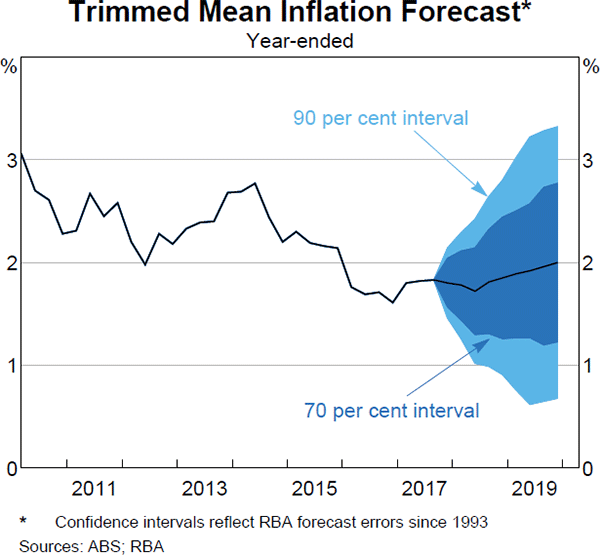
The legislated tobacco excise increases are expected to add more than ¼ percentage point to headline inflation in each of the next couple of years. An increase in fuel prices in the December quarter this year is expected to add a similar amount over the near term. Utilities price increases are also expected to be above average, although there is considerable uncertainty around this. The forecast improvement in the labour market is expected to lead to some build-up in unit labour cost pressures and thus support a gradual pick-up in underlying as well as headline inflation. However, working in the opposite direction, the continued entry of new foreign retailers into the Australian market is expected to constrain the ability of retailers to pass on higher costs, and therefore retail price inflation. Inflation expectations are expected to remain around current levels, while rent inflation is expected to remain well below average because of the continued increase in the supply of rental housing over the next couple of years.
Key Uncertainties
There are a number of key uncertainties surrounding the forecasts. For the global economy, the current expansion could be more self-sustaining than currently expected, particularly if investment growth gains momentum, leading to higher potential output growth. On the other hand, it remains possible that escalating geopolitical tensions and increased global trade protectionism could derail the current economic expansion. The long-standing financial stability risks associated with high levels of debt in the Chinese economy could damage prospects for global and domestic growth, should they be realised.
Domestically, one of the key sources of uncertainty for the forecasts is the outlook for the labour market. This comes from two sources. First, it is not clear how much spare capacity there is in the labour market and how quickly it might decline, particularly given the recent strength in the participation rate. Second, it is unclear how much the expected decline in spare capacity will translate into building wage pressures. Both these factors affect the outlook for inflation and household income growth, which is a key driver of consumption and therefore the GDP growth forecast. In terms of assessing the GDP growth forecast, the risks around the outlook for non-mining business investment are now seen as being more positive than previously.
The Chinese economy and commodity prices
Accommodative policy settings (including robust growth in public spending) and stronger-than-expected residential construction have supported growth in the Chinese economy over the past year. Continued strength in residential investment, despite intensified efforts by the authorities to slow housing market activity and prices, could result in Chinese growth being stronger than expected. Although announcements made at the 19th Party Congress signalled little change in near-term macroeconomic policies, they hinted that the authorities might be willing to accept lower growth and reiterated the commitment to tackle financial sector vulnerabilities through tighter regulation. The implementation of a stricter approach to financial supervision, if carried out more aggressively than expected, could lead to tighter financial conditions and lower growth than currently forecast. However, at the same time, these measures could lower the longer-run risks of a sharp financial disruption or crisis, which would pose a much greater threat to Chinese growth and the global economy.
The uncertainty surrounding China's growth outlook has implications for Australian resource exports, commodity prices and the terms of trade. The decision by Chinese authorities to implement substantial cuts to steel production for environmental reasons over the next few months increases the likelihood of near-term volatility in Chinese iron ore and coking coal demand and bulk commodity prices. The heightened focus on environmental protection and efforts to combat air pollution apparent in announcements surrounding the 19th Party Congress also raise the prospect that such disruptions could become more frequent in the future. However, insofar as these policies affect the supply side as well as the demand side of commodity markets, through their effects on China's domestic production, they create uncertainty in both directions around the trajectory for the terms of trade.
Spare capacity in the labour market
There is considerable uncertainty in estimating how much spare capacity there is in the labour market currently and how far it will decline over the forecast period. Spare capacity is expected to decline a little because employment is expected to grow faster than the working-age population, and average hours worked are expected to increase. These developments should lead to a fall in both the unemployment rate and the underemployment rate. However, the degree of spare capacity in the labour market also depends on how the participation rate responds to stronger labour demand.
The significant growth in employment over the past year has been accompanied by a notable rise in the participation of older workers and women aged 35–44 years, which has offset the downward pressure on the participation rate from the gradual ageing of the population. However, it is uncertain how much future employment growth will lead to further increases in the participation of particular groups, such as females, older and younger workers, migrants and temporary residents. The forecasts currently assume that the participation rate increases a little further, implying that the increase in participation from these groups is large enough to offset the effect of the ageing population. If this does not occur, the unemployment rate could be lower than currently forecast.
Growth in wages, household income and consumption
There is also uncertainty about how much wage growth will pick up in response to improved labour market conditions and the associated reduction in spare capacity. More firms have been indicating that they are finding it difficult to find suitable labour, which might lead to wage growth picking up more quickly than anticipated. On the other hand, the experience of low wage growth in many countries with tighter labour markets suggests that structural factors such as technological change and globalisation have had an important bearing on wage outcomes and could continue to do so for some time yet.
Uncertainty about wage growth translates into uncertainty about the growth in household income, which is one of the main determinants of consumption growth. It is not clear how resilient consumption growth might be to an extended period of low income growth. Consumption is expected to grow a bit faster than income over the forecast period, which is consistent with households viewing the current period of weak wage growth as temporary. If, however, households start viewing lower income growth as being more persistent, consumption growth could be somewhat lower than forecast. Weaker-than-expected growth in housing prices or changes in expectations about the likely path of interest rates could also lead to weaker consumption growth than is currently forecast.
Household indebtedness is high and debt levels relative to income have continued to edge higher because household credit growth has continued to outpace income growth. Steps taken by regulators have seen the growth in riskier types of lending to households moderate, but some risks remain. For example, a highly indebted household sector is likely to be more sensitive to changes in income or wealth, which could have implications for consumption growth. Also, consumption growth could be weaker for a time if indebted households choose to pay down debt more quickly rather than spend additional income.
Inflationary pressures
Given the importance of wage costs for businesses, an increase in wage growth would be expected to lead to a pick-up in cost pressures over time. There is considerable uncertainty about the size and timing of how wage cost pressures might pass through to consumer prices. The pass-through of wage costs is likely to be larger for CPI components that embody a larger labour component, such as many household services, and may take longer for components of the CPI that are facing heightened competitive pressures, such as consumer durables. Another consideration is that stronger-than-expected productivity growth could dampen the impact of rising wages on business's labour costs. Heightened competitive pressures and their effect on the ability of businesses to pass on cost pressures have been a feature of Australian inflation since around 2010. In theory, a change in competition should lead to lower margins but, after some period, the dampening effect of this adjustment on inflation should dissipate. Difficulty forecasting the persistence and intensity of competitive pressures presents another significant uncertainty for the inflation forecasts.
As always, the inflation forecasts have been conditioned on the assumption of no change in the Australian dollar exchange rate, which means that the exchange rate poses an additional uncertainty to the outlook for inflation, particularly for goods with a large imported component.
Business investment
Recent revisions to the national accounts indicate that non-mining investment growth has been stronger than previously thought. These revisions have removed some of the downside risks to non-mining investment discussed in previous Statements. Over the forecast period, non-mining investment is forecast to continue increasing, but the pace of the pick-up is still expected to be relatively gradual and less than what has been typical in previous expansions. As such, there is a risk that investment will pick up by more than is forecast, although leading indicators currently do not suggest that this is likely in the near term. One area of uncertainty relates to government infrastructure spending. Public investment growth is forecast to continue and much of this work has been done by the private sector for the public sector, which has supported business conditions over the past year or so. More recently, liaison contacts have reported that contracts to complete public infrastructure works have begun to support their own private investment in machinery and equipment. It is therefore possible that this infrastructure work generates larger flow-on effects and boosts private business investment by more than currently thought.